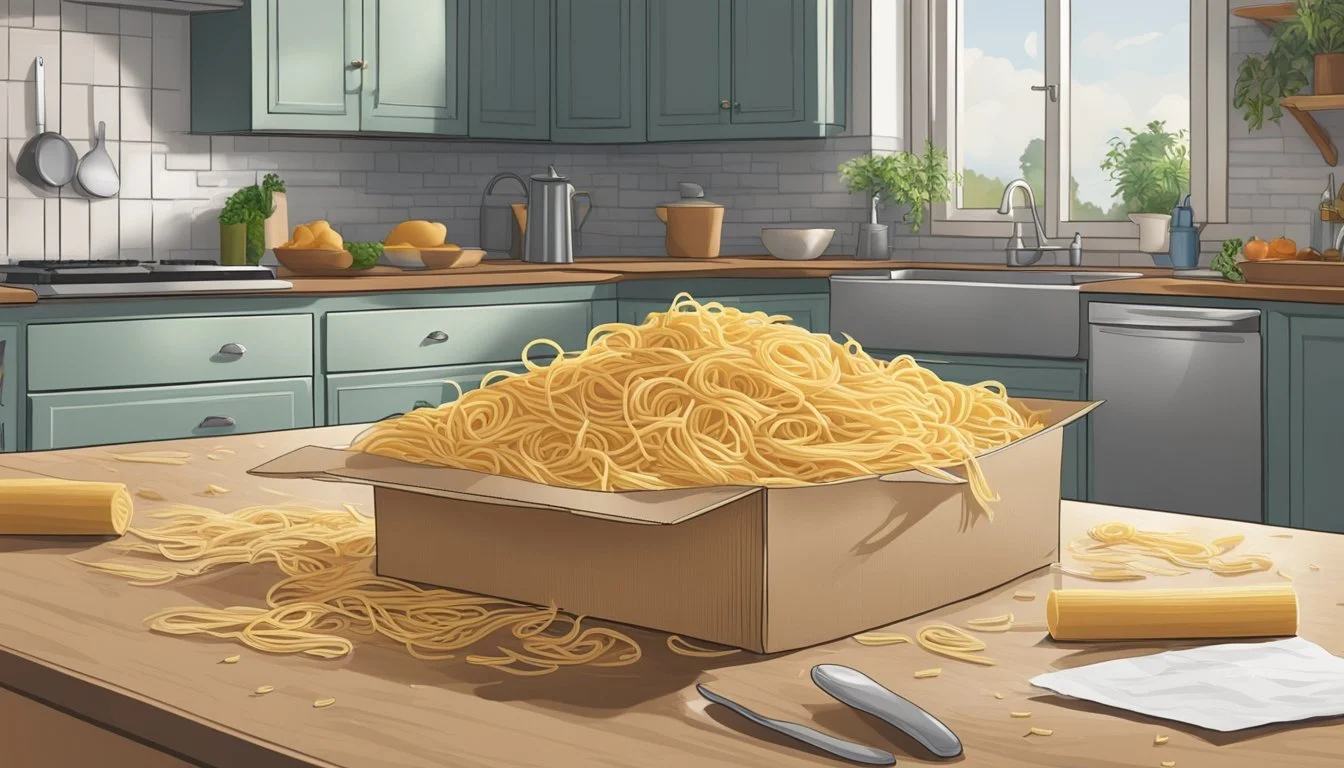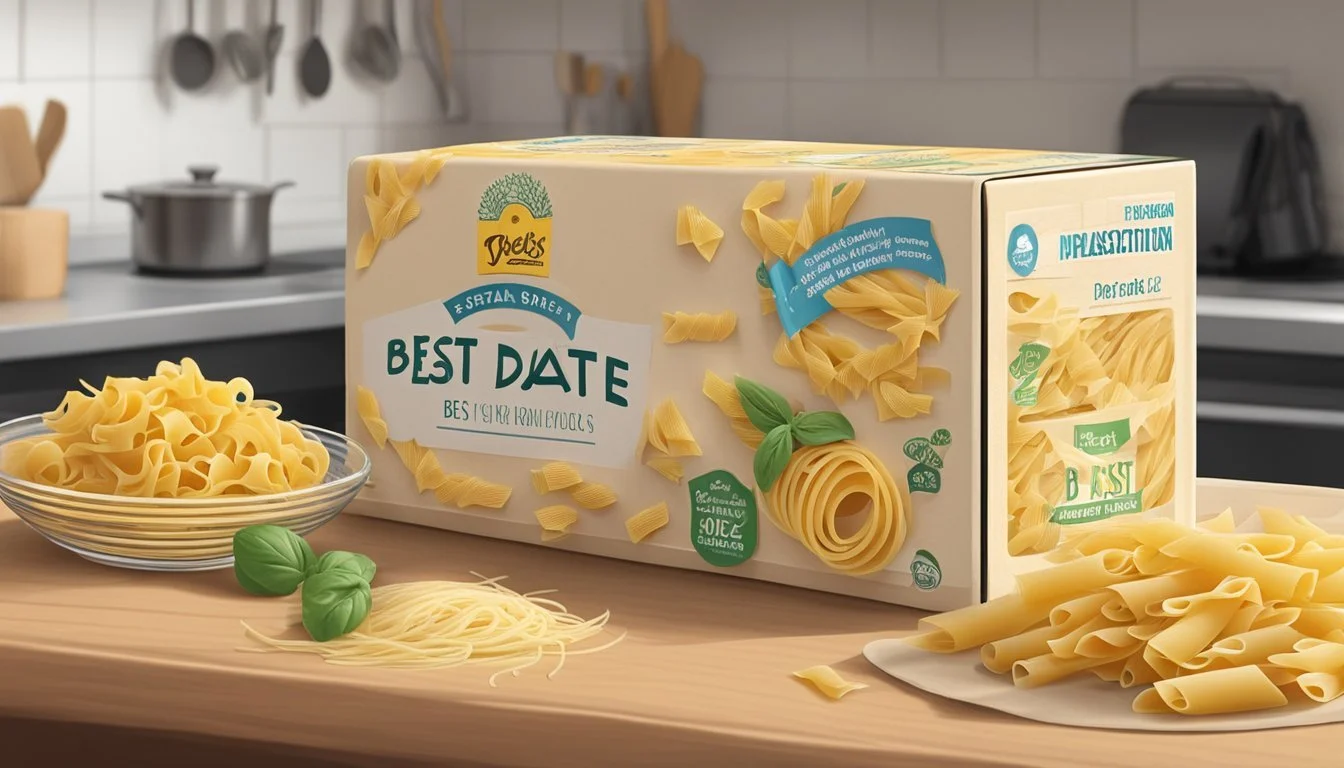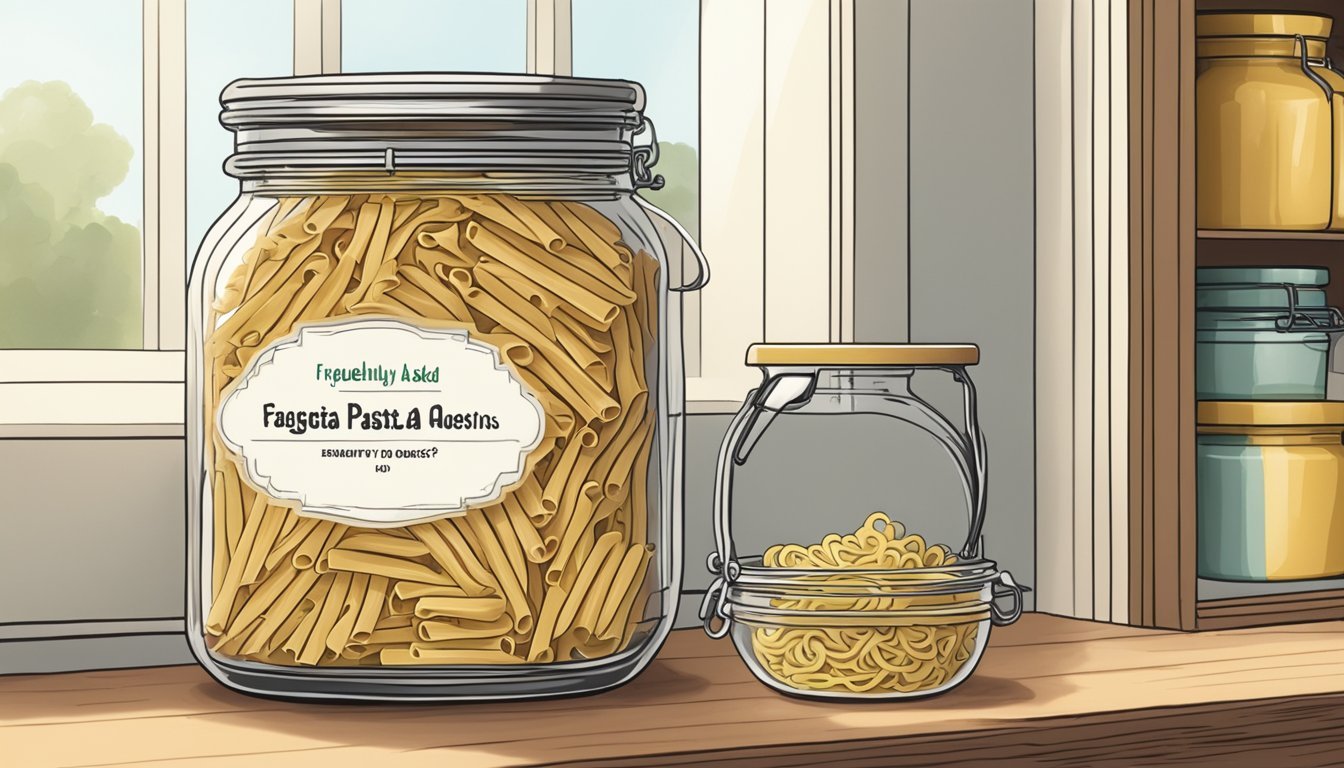How Long Does Pasta Last?
Shelf Life and Storage Tips
Pasta (What wine goes well with pasta?), a staple in many pantries worldwide, comes in various forms and therefore has differing shelf lives, largely dependent on whether it's dry or fresh. Dry pasta, known for its long shelf life, can remain edible for 1 to 2 years beyond its "best by" date when stored in a cool, dry place. This resilience is due to its low moisture content, which inhibits the growth of microorganisms that lead to spoilage. Even so, it's important to note that while dry pasta doesn't necessarily expire, its quality may diminish over time.
Fresh pasta (how long does fresh pasta last?), on the other hand, contains more moisture and often raw ingredients such as eggs, which considerably shortens its shelf life. When refrigerated, fresh pasta should ideally be consumed within two days of purchase to maintain its quality. If frozen, it can last up to two months. It’s crucial to store fresh pasta properly to prevent it from drying out or developing bacteria.
When considering cooked pasta, proper storage is key to extending its shelf life. Cooked pasta can last up to five days in the refrigerator and up to two months in the freezer. Quality, however, is best when consumed sooner rather than later. Airtight containers are recommended for storing cooked pasta to maintain freshness and prevent contamination.
Types of Pasta and Their Shelf Life
The longevity of pasta varies greatly depending on its type. Shelf-stable dry pasta usually has the longest shelf life, while perishable fresh and cooked pastas must be refrigerated and consumed quicker. Specialty pasta varieties, such as those with fillings or those made from alternative ingredients, often fall between these two categories regarding shelf life.
Dry Pasta
Dry pasta, the pantry staple made mainly from wheat and water, is known for its shelf-stability. Typically, dried pasta lasts for 1-2 years beyond its "best by" date, retaining its quality when stored properly in a cool, dry place. As grains like wheat are particularly shelf-stable when dried, pasta in this form is an ideal candidate for long-term storage.
Fresh Pasta
On the other side of the spectrum lies fresh pasta, which often contains eggs and must be kept refrigerated. Fresh pasta has a much shorter shelf life due to its higher moisture content and perishable ingredients. Consumers can expect fresh pasta to last for 4-5 days past its expiration date when stored in the refrigerator.
Cooked Pasta
Once pasta is cooked, its shelf life decreases significantly. Cooked pasta, or leftover pasta, can be kept in the fridge for up to five days. It should be noted that the addition of sauce or other perishable food items can affect this timeframe, potentially shortening the fridge life of the pasta dish.
Specialty Pasta Varieties
Specialty pasta varieties like gluten-free pasta made from alternative grains or legumes often share a similar fridge life of 3-5 days, akin to their wheat-based counterparts.
Stuffed pasta: Examples include tortellini or ravioli, which contain perishable fillings, typically remain good in the fridge for a similar timeframe of 3-5 days.
Lasagna and other cooked pasta with sauce: These prepared dishes can last up to 5 days in the refrigerator, although they may vary based on the specifics of their ingredients.
Proper storage in an airtight container can help extend the shelf life of these pasta types and maintain their quality.
Understanding Pasta Spoilage
When it comes to pasta spoilage, one must be mindful that pasta's longevity is compromised when exposed to certain environmental factors. Recognizing when pasta has gone bad and understanding what accelerates its deterioration is crucial to prevent food poisoning and waste.
Spotting Spoiled Pasta
Spoiled pasta can often be identified by visible signs such as:
Mold: The presence of fuzzy spots, often green or white, indicates mold growth.
Off-odor: A sour or an otherwise unpleasant smell is a strong indicator of spoilage.
Texture change: Pasta that is slimy or sticky has likely gone bad.
Discoloration: Any significant changes in color, apart for known ingredient-induced coloration, suggest deterioration.
Eating spoiled pasta can lead to food poisoning, with symptoms that include nausea, vomiting, and diarrhea. Hence, it's imperative to discard pasta if there's any doubt about its condition.
Factors Influencing Pasta Deterioration
The shelf life of pasta is influenced by several factors, including:
Moisture and Heat: Exposure to moisture or high temperatures can hasten bacteria growth and spoilage.
Air and Light: Oxygen can oxidize pasta, while light can degrade its quality, leading to stale, off-tasting noodles.
Storage Method: Properly sealed and refrigerated pasta will last longer than pasta left in open containers.
Pasta Type: Fresh pasta contains more moisture than dry pasta and thus has a shorter shelf life. Dry pasta, with its low moisture content, resists spoilage longer.
Presence of Contaminants: Introduction of bugs or existing bacteria from handling can lead to faster spoilage.
To extend pasta's shelf life and prevent spoilage, it should be stored in a cool, dry place sealed from air and light. Refrigeration is recommended for fresh pasta, while dry pasta is best kept in airtight containers. Mold growth and bacterial contamination are less likely under these conditions, making pasta safe to eat for longer periods.
Proper Pasta Storage Methods
Proper storage of pasta is crucial to preserve its quality and extend its shelf life. The methods differ based on the type of pasta, ranging from dry to fresh, and whether it has been cooked. It is important to select the right environment and container for each form.
Storing Dry Pasta
Dry pasta should be kept in airtight containers and placed in a cool, dark place such as a pantry. It is a pantry staple that, when stored correctly, can last for years without losing quality. Avoid exposure to heat, light, and moisture, as these can lead to degradation and potential infestation.
Storing Fresh Pasta
To store fresh pasta, it must be kept in an airtight container or tightly wrapped in plastic wrap to prevent it from drying out. Fresh pasta can be refrigerated for a few days. If not used within that timeframe, freezing is recommended to extend its shelf life.
Freezing Pasta
Freezing pasta is an excellent way to maintain its taste and texture for future use. To freeze pasta, one should lay it out on a baking sheet until frozen and then transfer it to a freezer-safe bag or container to avoid clumping. For optimal quality, use within three months.
Storing Cooked and Leftover Pasta
For cooked and leftover pasta, it's important to refrigerate it in airtight containers. Plain pasta can last in the refrigerator for 3-5 days. When reheating pasta, adding a small amount of water can help retain its moisture and prevent it from drying out.
Extended Storage Solutions
For long-term storage of dry pasta, using mylar bags with oxygen absorbers can extend the shelf life significantly. Alternatively, vacuum sealing removes air and can protect pasta for an extended period. Regular checks for signs of spoilage are essential.
Tips for Reheating Stored Pasta
Proper reheating techniques can preserve the flavor and texture of pasta. This section provides guidance on how to reheat stored pasta and ensure its quality post-reheating.
Reheating Techniques
Microwave: For quick reheating, individuals can place their pasta in a microwave-safe dish, sprinkle some water on top to prevent drying out, and cover it with a microwave-safe lid or plastic wrap. Heating it on medium power in 90-second intervals, stirring between each, helps distribute heat evenly.
Oven: If there's a preference for a crispy top layer, baking pasta in an oven-safe dish covered with foil at 350℉ for 15-20 minutes is effective. For added cheese, one can remove the foil towards the end and sprinkle additional cheese to melt.
Boiling Water: Dropping the pasta into boiling water for about 30 seconds can quickly reheat it while preserving its texture. This method works best for noodles without sauce.
Maintaining Pasta Quality After Reheating
To preserve quality post-reheating:
Avoid overcooking, which can make the pasta mushy. They should reheat it just enough to reach the desired temperature.
For leftover sauces, reheating them separately and then mixing with the pasta can help maintain the original flavor and texture.
Preventing Foodborne Illness from Pasta
Proper food storage practices are essential to prevent the growth of bacteria that can cause foodborne illnesses. Pasta, like many other foods, can be a breeding ground for bacteria if not stored correctly. To ensure food safety and minimize the risk of foodborne illnesses, individuals should follow these guidelines:
Cooling Down: Cooked pasta should be cooled to room temperature within two hours of cooking and before refrigeration to prevent bacterial growth.
Refrigeration: Once cooled, pasta should be stored in an airtight container and refrigerated at or below 40°F (4°C).
Shelf Life in the Fridge:
Fresh homemade pasta: 1-2 days
Cooked pasta without sauce: 3-5 days
Cooked pasta with sauce: 5 days
Stuffed pasta, like tortellini: 3-5 days
It is crucial to note that these time frames are guidelines, and any change in odor, color, or texture indicates spoilage and should be discarded.
Reheating: Ensure that leftovers reach an internal temperature of 165°F (74°C) to eliminate potential bacteria.
Avoid Cross-Contamination: Use separate utensils and cutting boards for raw and cooked foods.
By adhering to these practices, the chances of foodborne illness can be significantly reduced, and pasta can be enjoyed safely.
Considerations for Specific Diets
When it comes to pasta and specific dietary needs, consumers should be aware of the ingredient composition and shelf-life of specialty pastas. This ensures that individuals with food sensitivities or on gluten-free diets can enjoy pasta safely.
Gluten-Free Pasta Options
Gluten-free pasta generally replaces wheat with alternative ingredients such as rice(how long does rice last?), corn, or quinoa (how long does quinoa last?). These alternatives provide options for individuals with celiac disease or gluten intolerance. The storage life of gluten-free pasta varies based on the ingredients:
Rice-based pasta: Typically lasts as long as traditional wheat pasta and should be stored in a cool, dry place.
Bean-based pasta: Made from beans, such pasta not only avoids gluten but also adds protein to the diet. Its shelf-life is comparable to that of wheat pasta, assuming proper storage conditions.
Selecting Pasta for Food Sensitivities
When individuals have food sensitivities, scrutinizing ingredients becomes essential. Pasta might contain allergens such as eggs, so those with egg allergies must find egg-free options. Here's a quick reference for selecting pasta based on allergens:
Egg-free pasta: Often made from wheat or gluten-free substitutes; check labels for egg-free certifications.
Bean and legume pasta: A good choice for those avoiding eggs and gluten, but not suitable for individuals allergic to specific beans.
By selecting the appropriate pasta variant and understanding its storage and shelf-life, people with specific diets can enjoy this versatile food without compromising their health.
Pasta and Meal Prepping
Meal prepping with pasta offers an efficient way to plan meals for the week, ensuring a fast and convenient serving option. When prepping pasta, one should cook it al dente to avoid a mushy texture after reheating. Pasta retains its best quality for up to five days when stored in the refrigerator in airtight containers.
Key considerations for meal prepped pasta include:
Cooking: Prepare pasta al dente to maintain texture.
Cooling: Rinse under cold water to stop the cooking process.
Storing: Use airtight containers to optimize freshness.
In terms of sauces, a versatile tomato-based sauce pairs well and reheats easily with pasta. One can prepare the sauce separately and combine with pasta prior to serving or store them together to allow flavors to meld.
For those aiming to maintain the pasta's loose, non-sticky quality, a light coating of olive oil, or a neutral oil like vegetable or canola, can be applied post-cooking and pre-storing. Olive oil adds flavor, whereas neutral oils keep the pasta ready for a variety of dishes.
To summarize, meal prepping pasta involves:
Cooking pasta al dente.
Cooling it swiftly with cold water.
Combining with sauce if desired.
Storing it in airtight containers.
Optionally tossing with a choice of oils to retain quality.
Adhering to these methods ensures pasta remains a reliable and tasty option throughout the week.
Frequently Asked Questions
When storing pasta, the goal is to preserve its quality and extend its shelf life. This section answers key questions on how to store pasta for long periods, the varying shelf lives depending on storage conditions, and how to recognize when pasta has spoiled.
How to Store Pasta Long-Term
For optimal long-term storage, dry pasta should be kept in a cool, dry place preferably in a pantry. Utilizing mylar bags combined with oxygen absorbers can significantly increase shelf life by reducing the exposure to oxygen, which leads to degradation. This method provides the advantage of creating an almost oxygen-free environment, deterring insects and preventing the food from becoming moldy.
Shelf Life of Pasta in Different Storage Conditions
Pantry: Dry pasta can last for 1-2 years past its "best by" date if kept in its original packaging, or indefinitely in mylar bags with oxygen absorbers.
Refrigerator: Fresh pasta has a shorter shelf life, typically 4-5 days beyond its "best by" date.
Freezer: Cooked pasta can be stored in the freezer where it has a shelf life of 1-2 months.
Identifying Signs of Pasta Spoilage
One can usually determine if pasta has gone bad through visual and tactile cues. Spoiled pasta may exhibit:
Discoloration or spots
Off smells, which suggest bacterial growth
A slimy texture, which indicates the presence of mold
Careful inspection for these signs is important for food safety, especially when the pasta has been stored beyond the recommended time frame.





